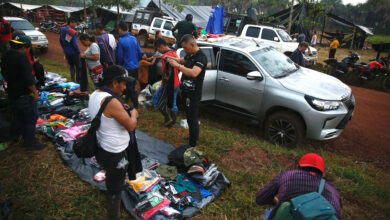The open wound of the First Nagorno-Karabakh war

By Farid Gajramanov
Edilli, Azerbaijan, Oct 5 (EFE).- The recent discovery of three mass graves in the Azerbaijani town of Edilli, recaptured by Baku in 2020, is a step forward in the long process of finding out what happened to the people who disappeared during The First Nagorno-Karabakh War nearly three decades ago.
A total of at least 18 bodies, presumably soldiers, were found in the graves, according to the Azerbaijani health ministry.
“This is proven by the discovery of fragments of clothing, shoes and soldiers’ belt badges,” head of the forensic medicine department of the health ministry, Nurana Guseinova, told Efe, adding that the graves were found just one kilometer from Edili.
The small village was in the “buffer zone” controlled by Armenia after it won the first ethnic conflict in 1994 before being recaptured by Azerbaijan in 2020 after a 40-day conflict.
The cause of death of the soldiers is yet to be determined, Guseinova said, suggesting they could have been shot either at the grave site or killed elsewhere.
“We will have a clearer idea about the fate of these people after the expert examination,” the forensic scientist said.
During the First Nagorno-Karabakh War between Azerbaijan and Armenia, over 4,500 people went missing, including some 4,000 Azeris and some 500 Armenians, Azerbaijani human rights activist, Rasul Khafarov, tells Efe.
“In the framework of the final settlement of the conflict between Azerbaijan and Armenia, mechanisms for resolving humanitarian issues must also be defined, including establishing the fate of the missing persons,” Khafarov says.
“Many of the people who have lost hope of ever seeing their relatives alive dream of at least finding their graves and bidding them an honorable farewell,” he continued to say.
The search for missing people is supported by the International Committee of the Red Cross (ICRC), which has been dealing with humanitarian problems generated by the Azerbaijani-Armenian conflict since 1992.
“The Red Cross offices in Baku and Barda registered 3,800 missing persons out of the 4,500,” Ilaha Guseinova, head of public relations at the ICRC representation in Baku, tells Efe.
But the search for missing people has been a challenge.
“On the basis of witness statements and other information, it was established that prisoners and hostages were taken to Edilli from surrounding territories. Here there was a distribution point from which they were then sent to other parts of Nagorno-Karabakh and Armenia,” Namik Efendiyev, a representative of Azerbaijan’s state commission for prisoners of war and missing persons, tells Efe.
According to Efendiyev, Armenians forced the remaining prisoners of war in the area to work on repairing roads with cobblestones taken from Azerbaijani houses destroyed during the conflict.
The conflict between Azerbaijan and Armenia began in 1988 when the mostly Armenian-populated enclave of Nagorno-Karabakh in Azerbaijani territory rose up to demand incorporation into Armenia.
The tensions led to a bloody war that killed over 30,000 people between 1992 and 1994 and resulted in an Armenian victory. EFE
fg-mos/mp/jt





